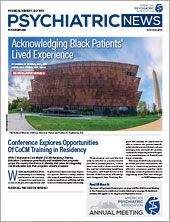Children aged 9 to 13 who experience sleep problems may be more likely to experience internalizing symptoms (such as depression and anxiety) and/or externalizing symptoms (such as aggression and rule-breaking behaviors) than children who do not experience sleep problems, according to a report in JAMA Psychiatry.
“Emotional and behavioral symptoms are closely intertwined across the transition from childhood to adolescence. That is, sleep problems and psychopathology symptoms are concurrent and difficult to separate,” senior author Vanessa Cropley, Ph.D., told Psychiatric News. She is a senior research fellow at the Melbourne Neuropsychiatry Center at the University of Melbourne. “This highlights the critical importance of sleep for a young person’s mental health.”
Cropley and colleagues analyzed data collected from 10,313 participants whose caregivers completed the Sleep Disturbance Scale for Children (SDSC) as part of the Adolescent Brain Cognitive Development (ABCD) Study when the youth were between the ages of 9 and 11 years and again two years later. Using the SDSC, the caregivers were asked about the youth’s experiences over the prior six months with such sleep problems as sleepwalking, nightmares, night sweats, sleep breathing disorders, troubles falling and/or staying asleep, and more. The caregivers also completed the 113-item Child Behavior Checklist, which asked about any internalizing or externalizing symptoms displayed by the youth in the previous six months.
The children were then categorized into four sleep disturbance profiles at baseline and at two-year follow-up:
•
Low disturbance (25.2% at baseline; 30.3% at follow-up).
•
Sleep onset/maintenance problems (16.0% at baseline; 32.6% at follow-up).
•
Moderate and nonspecific disturbance, or “mixed disturbance” (42.3% at baseline; 22.1% at follow-up).
•
High disturbance (16.5% at baseline; 15.0% at follow-up).
Compared with youth in the low sleep disturbances group, those who had greater sleep problems had a greater risk of both internalizing and externalizing symptoms at baseline and at the two-year follow-up. For instance, those in the high disturbance group were 1.44 times more likely to experience internalizing symptoms and 1.24 times more likely to have externalizing symptoms than children in the low disturbance group. Those in the sleep onset/maintenance problems group were 1.30 times more likely to experience internalizing symptoms and 1.20 times more likely to have externalizing symptoms compared with those in the low disturbance group. The strongest associations were observed for somatic distress, with roughly a 60% increase in symptom severity between the low disturbance and high disturbance groups.
Cropley said that the trajectory of sleep problems in young people is highly individualized.
“For some young people, sleep problems are highly comorbid, whereas for other young people, their sleep problems are quite specific, such as having difficulties in initiating or maintaining sleep. The stability of these problems were also shown to vary, with some young people developing a pattern of sleep problems over the transition to adolescence, whereas for other young people their pattern of sleep problems may reduce, or stay the same,” Cropley explained. She noted how the sleep onset/maintenance problems group nearly doubled in size over the follow-up period, indicating that these problems are particularly prevalent as children transition to adolescence.
“Sleep is critical for the mental health of young people and thus treating or improving sleep problems could be a powerful way to improve the mental health of a young person, including young people who have already sought help and are seeing a psychiatrist,” Cropley said. “Our study highlights that the assessment of sleep problems should be a key component of a mental health assessment and [should be] something that psychiatrists routinely do.”
Cropley added that sleep intervention programs, particularly those that address specific sleep problems or patterns of sleep problems, may be an additional strategy that psychiatrists and other mental health professionals can add to their toolkit to improve the mental health of their young patients.
“For some young people, treating or focusing on their sleep, rather than their mental health symptoms, may be more achievable. It is also something that parents can be … active participant[s] in,” she said.
This study was supported by the University of Melbourne, the National Health and Medical Research Council, and the Medical Advances Without Animals Trust. The Adolescent Brain Cognitive Development Study is supported by the National Institutes of Health and other federal partners. ■


